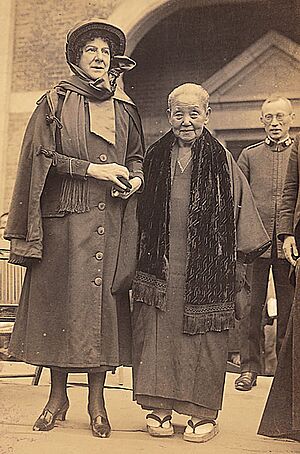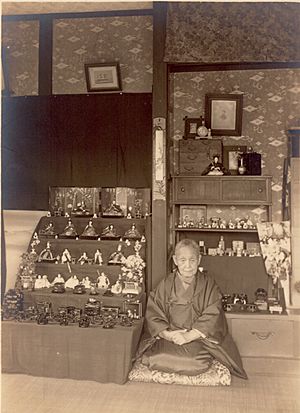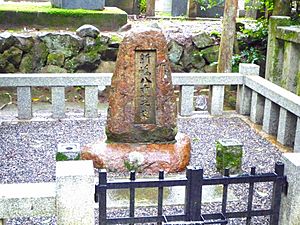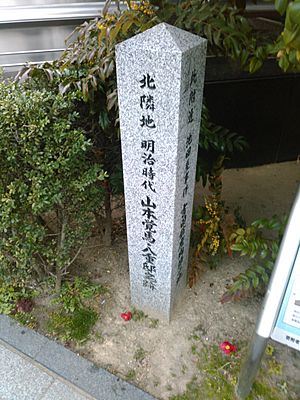Niijima Yae facts for kids
Quick facts for kids
Niijima Yae
|
|
|---|---|
| 新島八重 | |
 |
|
| Born |
Yamamoto Yae (山本八重)
1 December 1845 Aizu, Mutsu Province, Japan
|
| Died | 14 June 1932 (aged 86) |
| Resting place | Doshisha Cemetery, Kyoto, Japan |
| Nationality | Japanese |
| Other names | Yamamoto Yaeko (山本八重子) |
| Occupation | Nurse, former soldier |
| Spouse(s) |
Shonosuke Kawasaki
(m. 1865; div. 1871)Joseph Hardy Neesima
(m. 1876; died 1890) |
| Children | none |
| Parents |
|
| Relatives | Yamamoto Kakuma (brother) |
| Military career | |
| Allegiance | Aizu Domain |
| Years of service | 1868 |
| Battles/wars | Battle of Aizu |
Niijima Yae (新島八重, born Yamamoto Yae (山本八重); 1 December 1845 – 14 June 1932), also known as Yamamoto Yaeko (山本 八重子), was an amazing Japanese woman. She was a brave warrior, a dedicated teacher, a caring nurse, and a smart scholar. She lived during the end of Japan's old Edo period and into the early Shōwa period.
Yae came from a samurai family, the Hoshina clan, who were very loyal to the Tokugawa government. She was incredibly skilled with guns, which was very unusual for women at that time. She bravely helped defend her home, the Aizu Domain, during a big war called the Boshin War. Because of her courage, people called her the “Nightingale of Japan” and the “Bakumatsu Joan of Arc”.
Later in her life, Yaeko worked as a nurse during the Russo-Japanese War and the Sino-Japanese War. She was the first woman in Japan, outside of the Imperial family, to receive a special award for her service to the country after the Meiji Restoration in the 1870s. She was also famous as the wife of Joseph Hardy Neesima, who started the Doshisha English School in 1875. With help from an American missionary named Alice J. Starkweather, they also started the Doshisha Girls’ School a year later.
Contents
Niijima Yae: A Japanese Heroine
Early Life and a Brave Warrior
Yamamoto Yae was born in 1845. Her father, Yamamoto Gonpachi, was a samurai and a special instructor in gunnery for the Aizu Domain. Her family believed they were related to a famous general named Yamamoto Kansuke. In 1865, Yae married Shonosuke Kawasaki, a scholar from the Izushi Domain.
Fighting in the Boshin War
Yae was very good at using guns, which was quite rare for a woman in her time. She showed her bravery during the Boshin War, which started in 1868. She fought to defend Aizu when the new Meiji government's forces attacked. During the Battle of Aizu, she used her Spencer carbine to help defend Aizuwakamatsu Castle alongside other Aizu warriors.
After Aizu lost the war, Yaeko found safety in the nearby Yonezawa Domain for about a year. She and her husband, Shonosuke, separated after the defeat, as he became a prisoner of war. Their divorce was finalized in 1871.
Building Schools in Kyoto
In 1871, Yae moved to Kyoto to find her brother, Yamamoto Kakuma. He had been a prisoner of war for many years. When she arrived in Kyoto, her brother, who was advising the local government, helped her get a job. Yaeko became a substitute teacher at the Kyoto Women's School.
While working there, Yaeko met a teacher of the tea ceremony. She learned this beautiful art and became a qualified tea master in 1894, taking the special name Niijima Sōchiku (新島宗竹). She also learned flower arrangement and received a certificate for it in 1896.
In the early 1870s, Yaeko became a Christian. This happened after she met Reverend Joseph Hardy Neesima. Neesima was a former samurai who had studied in the United States for ten years. He returned to Japan in 1874 with a dream to build a Western-style school that also taught about Christianity. However, many people in Kyoto who followed Buddhism and Shinto did not like this idea.
Yaeko and Neesima became engaged in October 1875. Soon after, Yaeko lost her job at the women's school because of pressure from the government. But Yaeko, Neesima, and her brother Kakuma worked together. Yaeko played a very important part in starting the Doshisha English School and helping it grow.
Yaeko and Neesima got married on January 3, 1876. Neesima believed in women's rights because he had studied in the United States. With the help of an American missionary named Alice J. Starkweather, Yaeko opened a small school for girls. This school later became the Doshisha Branch School for Girls and then the Doshisha Girls' School in 1877.
Their marriage was different from what was normal in Japan at the time. Neesima treated Yaeko with great respect. Some people in Japanese society thought Yaeko was a "bad wife" because she was so spirited and independent. But Neesima and Yaeko were very happy together. He even wrote to his friends in the United States, saying her way of life was "handsome."
A Dedicated Nurse and Her Legacy
Sadly, Joseph Neesima died suddenly on January 23, 1890. After his death, Yaeko started to grow apart from some of her colleagues at Doshisha School. She didn't get along well with students from certain areas because those areas had fought against Aizu during the Boshin War.
Yaeko then decided to focus on nursing. She joined the Japanese Red Cross on April 26, 1890. During the First Sino-Japanese War, she joined the army as a nurse. She spent four months in Hiroshima, caring for wounded soldiers. She also worked to improve how trained nurses were seen in society. The Japanese government recognized her hard work and gave her the first Order of the Precious Crown in 1896.

After the First Sino-Japanese War, Yaeko taught in nursing schools. When the Russo-Japanese War began in 1904, she again joined the army. She volunteered as a nurse at an army hospital in Osaka for two months. For this service, she received her second Order of the Precious Crown. In 1928, she was given a special silver cup during the inauguration of the Shōwa Emperor for her lifelong dedication to Japan.
Later Years and Passing
Yaeko did not have any children of her own from her two marriages. However, she adopted three children from the Yonezawa Domain during her life. In her final years, she lived on Teramachi Street in Kyoto. She passed away on June 14, 1932, at the age of 86. Doshisha University held a funeral for her. Her burial place is at Doshisha Cemetery in Sakyō-ku, Kyoto.
Honours
- Order of the Precious Crown, Seventh Class
- Order of the Precious Crown, Sixth Class
In Popular Culture
Niijima Yae is a very popular historical figure in Japan. Her story has been told in many books, comics (manga), and TV shows.
- Stories
- Fukumoto Takehisa (ja), Niijima Yae series
-
- Aizu Onna Senki (1978)
- Niijima Jō to Sono Tsuma (1978)
- Handsome Woman, Saigo no Inori (2012)
- Mitsugu Saotome, Meiji no Keimai (1990)
- Manga
- Yae no Sakura, (2013) published by Shueisha. The story was written by Yamamoto Mutsumi, and the artwork was drawn by Takemura Youhei.
- TV
- The 2007 drama Byakkotai (ja) by TV Asahi, where she was played by Nakagoshi Noriko.
- Yae no Sakura, the 2013 NHK taiga drama, where she is the main character and played by Haruka Ayase.
- Games
- Tecmo Koei, Toukiden (2013)
See also
 In Spanish: Yamamoto Yaeko para niños
In Spanish: Yamamoto Yaeko para niños






